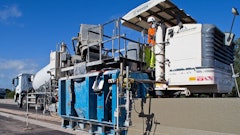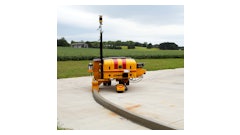
Highway 401 runs the length of Ontario, Canada, and is the main shipping route for trucks carrying goods between Canada and the United States. Traffic volume on the 401 is extremely high, so when the time came to replace a 6.5-mile section of the highway, officials at the Ministry of Transportation in Ontario decided to use concrete.
"This was an asphalt alternative project, but concrete won out over asphalt economically when the Ministry figured the life-cycle costs," says Rocky Coco, president of Coco Paving, Windsor, Ontario.
The Ministry tendered reconstruction of the 401 in May, 2004. The contract was awarded to Coco Paving at the end of that month and construction began by June 1.
"It was a very, very difficult time frame," Coco says. "The first phase of the project, which was four miles, had to be completed by the end of 2004."
Coco Paving owned Gomaco equipment, but it wanted a new paving train capable of handling the size and time frame of the project. The contractor purchased a new-generation PS-2600 placer/spreader; a GHP-2800 four-track paver with a front- and side-mounted bar inserter and In-The-Pan Dowel Bar Inserter (IDBI); and a T/C-600 texture/cure machine. It also added a four-track Commander III to slipform the variable barrier.
Originally, Coco Paving wanted to slipform the highway's three lanes (in each direction) in one pass. "It would have been our preferred choice. However, haul routes, the large ditches on each side of the highway and not being able to drive on the subgrade [made it] impossible," says Coco. "Gomaco's technical staff helped us come up with a cross-section where we'd do two lanes in one pour and a single lane with a partially paved shoulder in the second pour."
Equipment saves time and labor
Coco Paving is the prime contractor for the project and is handling all phases except for the bridge portions. Its responsibilities included building the open-graded drainage layer (OGDL).
"When we get our granular subgrade close, we put up our stringlines and use the same stringline to pretrim the grade with our 9500. We then place the OGDL, which is our underlying asphalt drainage layer," Coco says. The OGDL is made up of a .75-in. limestone rock coated with 2% asphalt cement. Coco's asphalt paver lays the OGDL and rollers compact it.
According to project specifications, the OGDL could not be driven on by anything but the paving train. Since concrete trucks couldn't dump on the grade directly in front of the paver, Coco chose to use a PS-2600 placer/spreader.
Concrete was delivered to the jobsite by end-dump trucks. The ground man working next to the PS-2600 placer/spreader directed the concrete truck traffic and kept production moving. "The major thing with the placer/spreader is to have a good ground man . . . who can move the trucks in and out," says Coco.
The GHP-2800 paver, with a front-mounted bar inserter for the longitudinal joint, IDBI and side-mounted bar inserter, slipformed the new roadway 10.25 in. thick. The width of the slab was either 23.8 ft. wide for two lanes or 14 ft. for the single lane.
Coco Paving had two IDBIs built to accommodate the project's two widths. With the paver's dual-telescoping capability, width changes could be completed and paving resumed in a matter of hours.
In the two-lane configuration, the IDBI inserted 23 bars across the width of the slab. For the single lane, it inserted 12 bars. The 1.25-in.-diameter bars are placed 11.8 in. apart.
Joint spacings were random based on Ministry specifications. The random spacings of 12, 14.8, 13 and 14.1 ft. were programmed into and managed by the IDBI's computer.
"It's amazing because we have people who really aren't computer oriented and they've picked it up just fine," Coco says. "The screens are very user-friendly and it's not intimidating equipment. Once you understand it, its functions and what it's trying to do, it's not difficult equipment to operate."
Coco's crew also enjoyed the labor the IDBI saved them. "Once our crew saw they didn't have to put baskets down anymore, they were elated. I don't think anyone wanted to nail or lug baskets around and the IDBI has worked out fantastic," Coco states. "Plus, with the labor costs to nail those baskets down, we felt the IDBI would pay itself off over the length of the contract."
Ministry officials wanted to ensure that the IDBI was placing the bars at the proper depth and alignment. This required a full, two-lane cut-through and removal of a section of the new highway.
"We did a full cut-through where we cut the bars in half so we could look at both faces," Coco explains. "We were right on and the consolidation around the bars was fantastic. The matrix of the aggregate around the bars was very good. You couldn't tell that the bars had been inserted."
Facing a new barrier
In Ontario, bonus incentive is paid out differently than in the United States. Three separate factors are taken into consideration.
"A third is the thickness, a third is the strength and a third is the rideability," Coco says. "They grade us on all three of those, combine them and that's how they determine what we're paid. We've had very good success and our ride has been really good."
The barrier wall has also been a successful venture for Coco Paving. Out of all the challenges faced on this project, the barrier wall was the one that worried Rocky Coco most.
At its tallest, the wall reaches 6 ft. high without any steel reinforcing. "My biggest concern was getting the barrier wall to stand up," Coco says. "The wall is variable in height up to 2.5 ft. in some areas. I think the most challenging part of the project was how we were going to get that concrete to sit up there 6 ft. high. I shouldn't have worried. The Commander III did an excellent job."
The first phase of the 401 reconstruction was successfully completed on schedule in 2004. Coco Paving is now nearing completion of the remaining 2.5 miles of the project.



























